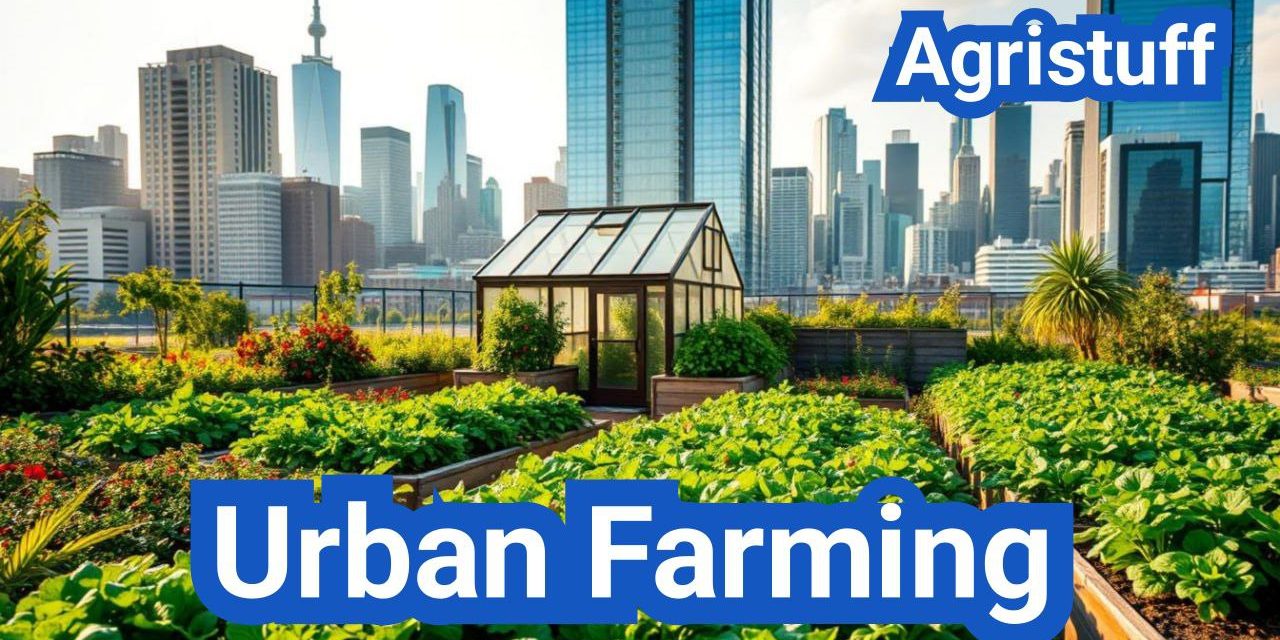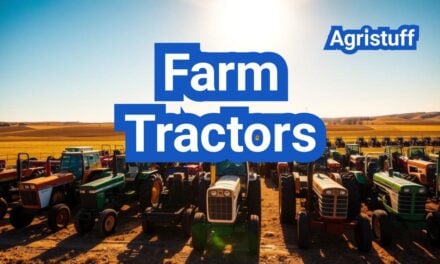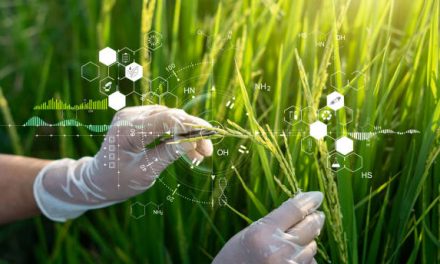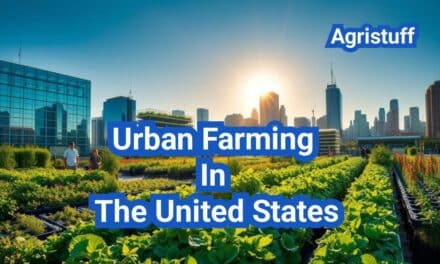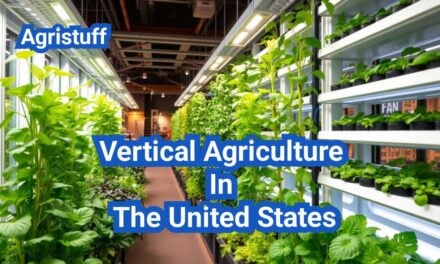City roots are taking hold as community agriculture gains momentum. The practice involves cultivating and distributing food in urban areas, promoting food security and fresh produce to communities.
From small-scale backyard gardening to large-scale commercial operations, urban agriculture is a rapidly expanding field. As the global population becomes increasingly urbanized, city farming is playing a critical role in providing fresh produce to communities.
Key Takeaways
- Urban farming encompasses a wide range of activities, from backyard gardening to commercial farming operations.
- Community agriculture promotes food security and fresh produce to communities.
- City farming is a rapidly expanding field with various techniques and benefits.
- Urban agriculture can take many forms, including vertical farming and rooftop farming.
- Sustainable urban farming practices are becoming increasingly important.
What Is Urban Farming?
Urban farming, or urban agriculture, refers to the practice of growing and distributing food within urban environments. This multifaceted concept involves a range of activities, from farming and gardening to animal husbandry, all aimed at providing fresh produce to local communities.
Definition and Core Concepts
At its core, urban farming is about cultivating and distributing food in urban areas, promoting food security and sustainability. Urban farmers use various techniques, including hydroponics, aeroponics, and traditional soil-based farming, to grow a wide variety of crops.
The core concepts of urban farming revolve around sustainability, community engagement, and innovative farming practices. By utilizing underused urban spaces, such as rooftops, vacant lots, and even indoor areas, urban farmers can turn these into productive agricultural lands.
The Urban Farmer’s Mission
The mission of an urban farmer is not just to grow food but to contribute to the well-being of the community. This involves promoting community farming initiatives, educating the public about sustainable practices, and working towards environmental stewardship.
Urban farmers play a crucial role in enhancing food security, reducing the carbon footprint associated with food transportation, and fostering community development through their work.
The Evolution of Urban Farming

The concept of urban farming is not new, with historical roots that stretch back thousands of years. Urban agriculture has been a vital part of city life, providing fresh produce to urban populations.
Historical Context
Urban farming dates back to ancient civilizations, where cities like Babylon and Rome practiced forms of urban agriculture. In more recent history, during World War I and II, urban farming played a crucial role in food production, with victory gardens providing a significant portion of the produce consumed by the population.
“The war effort depended on the home front, and victory gardens were a key part of that effort, providing food and boosting morale.”
USDA
Modern Developments in City Farming
Today, urban farming continues to evolve, incorporating new technologies and methods such as hydroponics, vertical farming, and container gardening. These modern developments have made it possible to farm in even the most challenging urban environments.
| Technique | Description | Benefits |
|---|---|---|
| Hydroponics | Growing plants in a nutrient-rich solution rather than soil. | Increased crop yields, water efficiency. |
| Vertical Farming | Farming in vertically stacked layers, often in indoor environments. | Maximizes space, reduces land use. |
| Container Gardening | Growing plants in containers, often on balconies or rooftops. | Flexibility, ease of maintenance. |
These advancements have transformed urban farming, making it more efficient, productive, and accessible to urban dwellers.
Why Urban Farming Matters Today
The importance of urban farming cannot be overstated, as it tackles food security, environmental concerns, and community development. Urban farming is critical for promoting food security, particularly in urban areas where access to fresh produce may be limited.
Food Security in Urban Areas
Urban farming provides fresh, locally grown produce, improving the health and well-being of urban residents. Some key benefits include:
- Increased access to fresh produce
- Reduced reliance on industrial agriculture
- Enhanced food safety through reduced transportation
Environmental Impact
Urban farming helps reduce the environmental impact of industrial agriculture by promoting local food systems and reducing carbon footprints. Key environmental benefits include:
- Reduced greenhouse gas emissions
- Conservation of water and soil
- Urban heat island mitigation through green spaces
Community Building Through Agriculture
Urban farming fosters community engagement and social cohesion by creating shared green spaces. This leads to:
- Stronger community bonds
- Educational opportunities on sustainable practices
- Increased community pride and ownership
By addressing food security, environmental impact, and community building, urban farming emerges as a vital component of sustainable urban development.
Types of Urban Farming
Urban agriculture is not a one-size-fits-all endeavor; it comes in various forms. As cities continue to grow and the need for sustainable food systems increases, different types of urban farming are emerging to meet these demands.
Backyard and Small Plot Farming
Backyard and small plot farming involve cultivating food in residential areas, utilizing spaces such as backyards, balconies, or rooftops. This type of farming is ideal for individuals or families looking to grow their own produce. It’s a great way to utilize otherwise wasted space and can be as simple or as complex as the gardener desires.
Community Gardens and Shared Spaces
Community gardens and shared spaces provide opportunities for community members to come together and grow food. These gardens are often located on vacant lots or other underutilized areas and serve as hubs for community activity. As one urban farmer noted,
“Community gardens are not just about growing food; they’re about building community.”
Institutional Urban Farms
Institutional urban farms involve farming on institutional land, such as schools, hospitals, or government buildings. These farms not only provide fresh produce but also serve as educational tools, teaching individuals about sustainable food systems and nutrition.
Commercial Urban Agriculture Ventures
Commercial urban agriculture ventures involve large-scale farming operations that produce food for sale. These operations can range from rooftop farms to indoor growing facilities and are becoming increasingly sophisticated, incorporating technologies like hydroponics and vertical farming. They represent a significant shift towards local food production and can help reduce the carbon footprint associated with transporting food.
In conclusion, the diversity in types of urban farming allows for a wide range of participation, from individual gardeners to large commercial operations. Each type plays a vital role in enhancing food security, sustainability, and community engagement in urban areas.
Urban Farming Techniques and Methods

Effective urban farming relies on a combination of traditional and modern techniques. Urban farmers use a variety of methods to cultivate food in urban areas, maximizing space and yield.
Container Gardening for Limited Spaces
Container gardening involves growing plants in containers, which is ideal for urban areas with limited space. This method allows for flexibility and can be adapted to balconies, rooftops, or indoor spaces. Container gardening is particularly useful for growing herbs, leafy greens, and other small crops.
Raised Bed Cultivation
Raised bed cultivation involves building raised beds to improve soil quality and drainage. This technique enhances soil structure, reduces soil compaction, and allows for better root growth. Raised beds are commonly used for growing a variety of vegetables and flowers.
Vertical Growing Systems
Vertical growing systems involve using trellises, arbors, or other supports to grow plants upwards, maximizing space and increasing yields. This method is particularly effective for vining plants like tomatoes, peas, and cucumbers. Vertical gardening can also be used to create green walls and improve urban aesthetics.
| Technique | Description | Benefits |
|---|---|---|
| Container Gardening | Growing plants in containers | Space-saving, flexible |
| Raised Bed Cultivation | Building raised beds for improved soil quality | Better drainage, reduced soil compaction |
| Vertical Growing Systems | Using supports to grow plants upwards | Maximizes space, increases yields |
By employing these urban farming techniques, individuals can successfully cultivate a wide range of crops in urban environments, contributing to food security and sustainability.
Vertical Farming in Urban Environments
Vertical farming is revolutionizing the way we grow crops in urban environments. By utilizing vertically stacked layers, often in indoor settings, this method maximizes space while minimizing environmental impact.
Principles of Vertical Farming
The core principle of vertical farming involves growing plants in controlled, vertically stacked layers. This approach often incorporates hydroponics or aeroponics, allowing for precise control over nutrient delivery and water usage.
Technologies and Systems
Various technologies support vertical farming, including LED lighting, climate control systems, and automated nutrient delivery. These systems work together to create an optimal growing environment, regardless of external weather conditions.
Space Efficiency Benefits
One of the primary advantages of vertical farming is its ability to increase crop yields in limited urban environments. By stacking layers of crops, farmers can achieve higher production levels without requiring more land, thus enhancing space efficiency.
In conclusion, vertical farming offers a promising solution for urban food production, combining innovative technologies with efficient use of space to meet the demands of a growing urban population.
Rooftop Farming and Green Roofs

By converting rooftops into farms, cities can improve food security and reduce environmental impact. Rooftop farming involves cultivating food on rooftops, often using containers or raised beds. This innovative approach to urban farming not only provides fresh produce to urban residents but also helps mitigate the urban heat island effect, improves air quality, and reduces stormwater runoff.
Design Considerations
When designing a rooftop farm, several factors must be considered. These include the structural integrity of the building, drainage, and accessibility. Proper drainage is crucial to prevent water accumulation, which can damage the structure or lead to plant root rot. Additionally, the design should incorporate access paths for maintenance and harvesting.
| Design Element | Description | Importance |
|---|---|---|
| Drainage System | Ensures water does not accumulate | High |
| Accessibility | Paths for maintenance and harvesting | High |
| Irrigation System | Automated or manual watering system | Medium |
Structural Requirements
The structural requirements for rooftop farming are critical to ensure the safety and feasibility of the project. The building must be able to support the weight of the soil, plants, and any additional infrastructure like irrigation systems. Consulting with a structural engineer is essential to assess the building’s capacity and make necessary adjustments.
Success Stories and Case Studies
Several cities have seen successful rooftop farming projects. For example, the Chicago City Hall’s green roof is a notable case study, reducing stormwater runoff and providing insulation. Similarly, rooftop farms in New York City have become models for urban agriculture, showcasing the potential for green roofs to transform urban landscapes.
Hydroponic Urban Farming

The concept of hydroponic urban farming offers a promising solution for food production in densely populated areas. By growing plants in a nutrient-rich solution rather than soil, hydroponics provides a highly efficient and productive method of urban farming.
How Hydroponics Works
Hydroponics involves suspending plant roots in a nutrient-rich solution, providing them with the necessary nutrients for growth. This method allows for precise control over the nutrients delivered to the plants, resulting in faster growth rates and higher yields.
Key benefits of hydroponics include:
- Water conservation: Hydroponics uses significantly less water than traditional farming methods.
- Increased crop yields: By optimizing nutrient delivery, hydroponics can increase crop yields.
- Reduced land use: Hydroponics can be implemented in small or irregularly shaped spaces.
Setting Up a Basic Hydroponic System
To set up a basic hydroponic system, you’ll need a few essential components, including a grow tank, a pump, and a nutrient solution. The type of hydroponic system you choose will depend on your specific needs and resources.
Crops Suitable for Hydroponics
Hydroponics is particularly well-suited for growing leafy greens, herbs, and other crops that thrive in controlled environments. Some popular choices for hydroponic cultivation include lettuce, kale, and basil.
“Hydroponics is a game-changer for urban farming, allowing us to grow fresh produce in even the most challenging environments.”
Indoor Urban Farming Solutions

Indoor urban farming offers a sustainable way to produce fresh produce in urban environments. By utilizing controlled environments, urban farmers can optimize growing conditions, reduce environmental impact, and increase crop yields.
Grow Lights and Climate Control
One of the critical components of indoor urban farming is the use of grow lights. These specialized lights provide the necessary spectrum and intensity for plant growth, allowing farmers to cultivate crops indoors year-round. Climate control systems are also essential, as they enable farmers to regulate temperature, humidity, and air circulation, creating optimal conditions for a wide range of crops.
Microgreens and Herbs Production
Microgreens and herbs are particularly well-suited for indoor urban farming. These crops require minimal space and can be grown using hydroponics or other soilless cultivation methods. Microgreens, for example, are harvested within 1-3 weeks of germination and can be grown in vertically stacked systems, maximizing space efficiency.
Year-Round Growing Strategies
Indoor urban farming enables year-round production of crops, regardless of external weather conditions. By controlling the indoor environment, farmers can implement continuous production cycles, ensuring a consistent supply of fresh produce to local markets. This approach also allows for the cultivation of a diverse range of crops, from leafy greens to herbs and microgreens.
By leveraging indoor urban farming solutions, urban farmers can contribute to a more sustainable and resilient food system, providing fresh produce to local communities while minimizing environmental impact.
Smart Urban Agriculture Technologies

The integration of advanced technologies is transforming urban farming into a more efficient and productive practice. Smart urban agriculture involves the use of cutting-edge solutions to optimize crop yields, reduce waste, and minimize environmental impact.
Automation and Monitoring Systems
Automation plays a crucial role in smart urban agriculture by enabling farmers to monitor and control growing conditions remotely. Automated systems can regulate temperature, humidity, and light levels, ensuring optimal conditions for crop growth. Monitoring systems equipped with sensors can detect issues early, allowing for prompt intervention.
Data-Driven Farming Approaches
Data-driven farming involves the collection and analysis of data to inform farming decisions. By leveraging data analytics, urban farmers can optimize crop selection, planting schedules, and resource allocation. This approach enables farmers to predict and respond to challenges more effectively, improving overall efficiency.
IoT Applications for Urban Farms
The Internet of Things (IoT) is revolutionizing urban farming by connecting devices and sensors to create a network of real-time data. IoT applications enable farmers to monitor soil moisture, track weather conditions, and manage irrigation systems remotely. IoT technology enhances the precision and efficiency of urban farming operations.
By embracing smart urban agriculture technologies, farmers can create more sustainable, productive, and resilient food systems. As the world continues to urbanize, these innovations will play a vital role in meeting the food needs of growing city populations.
Benefits of Urban Farming

By integrating agriculture into urban landscapes, urban farming yields numerous benefits for the environment and communities. Urban farming is not just about growing food; it’s about creating sustainable ecosystems within cities.
Environmental Advantages
Urban farming offers several environmental advantages, including reduced carbon footprints due to minimized transportation needs, and the mitigation of the urban heat island effect through green spaces. As Lucy Robinson, an urban agriculture expert, notes, “Urban farms can transform urban environments by providing green oases that help regulate the climate.”
Economic Opportunities
Urban farming also presents economic opportunities for urban residents. By creating jobs and stimulating local economies, urban farming can contribute to community development. For instance, urban farms can sell their produce locally, providing fresh produce to consumers and generating income for farmers.
Health and Nutritional Benefits
The health and nutritional benefits of urban farming are significant. By providing access to fresh, nutritious produce, urban farming can improve dietary habits and overall health. As Nina Fedoroff, a renowned botanist, states, “Urban agriculture can play a critical role in enhancing food security and nutrition.” Urban farms often engage in practices that promote biodiversity, further enriching the nutritional quality of the food produced.
Social and Community Impact
Urban farming has a profound social and community impact. It fosters community engagement, promotes educational opportunities, and can serve as a catalyst for community development projects. Urban farms often become community hubs, bringing people together around the shared goal of sustainable food production.
In conclusion, the benefits of urban farming are multifaceted, ranging from environmental advantages to economic opportunities, health benefits, and social and community impact. As cities continue to evolve, the role of urban farming in creating sustainable, resilient urban environments will only continue to grow.
Challenges and Solutions in Urban Farming

Urban farming, while offering a sustainable solution to food production, is confronted with several obstacles that require innovative solutions. As the world shifts towards more urbanized living, the importance of addressing these challenges becomes increasingly evident.
Space Limitations and Creative Workarounds
One of the significant challenges in urban farming is space limitations. Urban areas often have limited space available for farming. However, urban farmers have found creative workarounds, such as vertical farming and container gardening, to maximize space usage.
Soil Contamination Issues
Soil contamination is another issue urban farmers face. Urban soils can be contaminated with pollutants, making them unsuitable for farming. Solutions include using raised beds with clean soil and implementing soil remediation techniques.
Water Management Strategies
Effective water management is crucial in urban farming. Techniques such as rainwater harvesting and drip irrigation help conserve water while ensuring crops receive adequate hydration.
Navigating Regulatory Hurdles
Urban farming is also subject to various regulatory hurdles. Understanding local laws and regulations is key. Urban farmers can navigate these challenges by engaging with local authorities and advocating for supportive policies.
By acknowledging and addressing these challenges, urban farming can continue to thrive, providing fresh produce to urban communities while promoting sustainability.
Getting Started with Urban Farming

Getting started with urban farming involves several key steps that can help you create a thriving garden. Whether you have a small balcony or a large backyard, urban farming can be a rewarding experience that provides fresh produce and beautifies your urban space.
Assessing Your Available Space
The first step in urban farming is assessing the space you have available. Consider the size of your area, the amount of sunlight it receives, and the soil condition. For small spaces, container gardening or vertical farming can be effective methods to maximize your area.
Choosing What to Grow
Choosing the right crops is crucial for a successful urban farm. Consider growing leafy greens, herbs, or vegetables that thrive in your local climate. If you’re new to urban farming, starting with easy-to-grow plants like tomatoes or cucumbers can be a good idea.
Essential Tools and Materials
To start your urban farm, you’ll need some essential tools and materials. These include:
- Containers or raised beds
- Soil or a soilless growing medium
- Seeds or seedlings
- Watering cans or irrigation systems
- Gardening gloves and tools
Planning Your Urban Farm Layout
Planning the layout of your urban farm is vital to ensure maximum productivity. Consider the space needed for each plant, the accessibility of the area, and the aesthetic appeal. A well-planned layout can help you make the most of your available space.
| Urban Farming Method | Description | Space Requirement |
|---|---|---|
| Container Gardening | Growing plants in containers | Low to Medium |
| Vertical Farming | Growing plants vertically | Low |
| Raised Bed Cultivation | Growing plants in raised beds | Medium to High |
Seasonal Planning for Urban Farmers
Effective seasonal planning is key to successful urban farming. Urban farmers must consider the changing weather conditions and seasonal fluctuations in demand to maximize their yields and minimize losses.
Spring Preparations and Planting
In the spring, urban farmers prepare the soil, repair any damage from winter, and start planting early crops such as lettuce and spinach. Succession planting is a technique used to ensure a continuous harvest by planting small batches of seeds every few weeks.
Summer Maintenance and Harvesting
During the summer, the focus shifts to maintaining the health of the crops and harvesting. Regular watering, weeding, and pest management are crucial.
| Season | Tasks | Crops |
|---|---|---|
| Spring | Soil preparation, planting | Lettuce, spinach |
| Summer | Maintenance, harvesting | Tomatoes, peppers |
| Fall | Transitioning, preserving | Root vegetables |
| Winter | Planning, projects | Microgreens |
Fall Transitions and Preservation
In the fall, urban farmers transition their crops to prepare for the colder months. Preservation techniques such as canning and freezing help extend the harvest.
Winter Projects and Planning
Winter is a time for urban farmers to plan for the upcoming year, repair equipment, and work on projects such as building new raised beds.
Sustainable Practices for Urban Farmers
Sustainable practices are crucial for urban farming, enabling farmers to minimize waste and maximize yields. By adopting environmentally friendly techniques, urban farmers can reduce their ecological footprint while promoting food security and sustainability.
Composting and Soil Health Management
Composting is a vital practice for urban farmers, as it helps to manage waste and create nutrient-rich soil. By composting organic materials, farmers can improve soil structure, increase fertility, and support healthy microbial activity. This, in turn, enhances crop growth and reduces the need for synthetic fertilizers.
Effective composting involves balancing “green” materials (such as food scraps and grass clippings) with “brown” materials (like dried leaves and straw). Regular turning and monitoring of the compost pile are also essential to maintain optimal conditions.
Water Conservation Techniques
Water conservation is critical in urban farming, where water resources may be limited. Techniques such as drip irrigation and mulching can significantly reduce water usage. Drip irrigation delivers water directly to the roots of plants, minimizing evaporation and runoff.
Mulching involves applying a layer of organic material to the soil surface, helping to retain moisture, suppress weeds, and regulate soil temperature. Both practices contribute to more efficient water use and healthier crops.
Integrated Pest Management
Integrated Pest Management (IPM) is a holistic approach to managing pests that combines physical, cultural, biological, and chemical controls. Urban farmers can use IPM strategies to minimize the use of chemical pesticides and maintain ecosystem balance.
IPM involves monitoring pest populations, identifying thresholds for action, and implementing a combination of control methods. This might include introducing beneficial insects, practicing crop rotation, and using physical barriers to prevent pest damage.
By integrating these sustainable practices into their operations, urban farmers can enhance the environmental, social, and economic viability of their farms.
Community Engagement and Urban Farming
As urban farming continues to grow, so does the importance of community engagement in this movement. Urban farming is not just about producing food; it’s about building a community around it. By engaging with their communities, urban farmers can create a more sustainable and resilient food system.
Building Local Food Networks
One of the key aspects of community engagement in urban farming is the development of local food networks. These networks allow farmers to share resources, knowledge, and produce, thereby strengthening the local food system. For instance, a local food network might include a community-supported agriculture (CSA) program, where consumers buy shares of a farm’s produce on a regular basis.
Educational Opportunities
Urban farming also provides numerous educational opportunities for community members. Workshops on sustainable farming practices, cooking classes using fresh produce, and educational tours of urban farms are just a few examples. These initiatives not only educate the community but also foster a sense of unity and cooperation.
Collaborative Projects and Resource Sharing
Collaborative projects and resource sharing are vital components of community engagement in urban farming. By working together, urban farmers can share tools, knowledge, and expertise, reducing costs and improving efficiency. For example, a group of urban farmers might collaborate on a large-scale composting project, turning food waste into valuable fertilizer.
| Benefits of Community Engagement | Description |
|---|---|
| Local Food Networks | Strengthens local food systems through resource and knowledge sharing |
| Educational Opportunities | Fosters community education on sustainable practices and healthy eating |
| Collaborative Projects | Enhances efficiency and reduces costs through shared resources and expertise |
Finally: The Future of Urban Farming
The future of urban farming is bright, with opportunities for growth, innovation, and sustainability. As the global population becomes increasingly urbanized, urban agriculture will play a critical role in promoting food security, sustainability, and community development.
By leveraging new technologies, techniques, and collaborative approaches, urban farmers can create more resilient and sustainable urban environments. This, in turn, promotes a healthier and more sustainable food system, aligning with the principles of sustainability.
The future of urban farming holds much promise, with the potential to transform urban landscapes and foster community engagement. As urban agriculture continues to evolve, it is likely to have a lasting impact on the way cities produce and consume food.
FAQ
What is urban farming?
Urban farming is the practice of cultivating and distributing food in urban areas, with the goal of providing fresh produce to local communities. It encompasses a wide range of activities, from small-scale backyard gardening to large-scale commercial farming operations.
What are the benefits of urban farming?
Urban farming provides a range of benefits, including environmental advantages, economic opportunities, health and nutritional benefits, and social and community impact. It promotes food security, sustainability, and community engagement, while creating more resilient and sustainable urban environments.
What techniques are used in urban farming?
Urban farmers use a range of techniques, including container gardening, raised bed cultivation, vertical growing systems, hydroponics, and aeroponics. These techniques allow for maximum space efficiency and yields, while minimizing environmental impact.
What is vertical farming?
Vertical farming is a highly efficient and productive method of urban farming that involves growing plants in vertically stacked layers, often in indoor environments. It uses hydroponics, aeroponics, or other soilless cultivation methods to maximize space and increase yields.
How does hydroponics work in urban farming?
Hydroponics involves growing plants in a nutrient-rich solution rather than soil. It is a highly efficient and productive method of urban farming that maximizes yields, while minimizing water usage and environmental impact.
What are the challenges faced by urban farmers?
Urban farmers face a range of challenges, including space limitations, soil contamination, regulatory hurdles, and water management issues. However, by using creative workarounds, such as vertical farming and hydroponics, urban farmers can overcome these challenges.
How can I get started with urban farming?
Getting started with urban farming involves assessing available space, choosing crops, acquiring essential tools and materials, and planning your urban farm layout. By planning carefully and using creative workarounds, urban farmers can create productive and sustainable gardens.
What is smart urban agriculture?
Smart urban agriculture involves using advanced technologies, such as automation, data-driven farming approaches, and IoT applications, to improve the efficiency and productivity of urban farming. It allows urban farmers to optimize growing conditions, reduce waste, and increase yields.
How does urban farming promote community engagement?
Urban farming promotes community engagement by building local food networks, providing educational opportunities, and fostering collaborative projects and resource sharing. It helps to create more resilient and sustainable urban environments.
What is the future of urban farming?
The future of urban farming is bright, with opportunities for growth, innovation, and sustainability. As the global population becomes increasingly urbanized, urban farming will play a critical role in promoting food security, sustainability, and community development.
Conclusion of: Urban Farming
What Is Urban Farming?
Urban farming refers to the practice of cultivating, processing, and distributing food in or around urban areas. It encompasses various methods, from rooftop gardens to hydroponic systems, aiming to bring food production closer to consumers. This sustainable approach not only shortens supply chains but also enhances food security in densely populated regions. Learn more from the USDA about urban agriculture
Why Urban Farming Matters
Urban farming addresses multiple challenges in modern cities: food insecurity, environmental degradation, and social inequality. By turning vacant lots and rooftops into green spaces, cities reduce carbon emissions, promote biodiversity, and empower communities through local food initiatives. Check out the FAO’s insights on the impact of urban farming
Types of Urban Farming
Urban farming takes various forms, including container gardening, vertical farming, hydroponics, aquaponics, and community gardens. Each type suits different spaces and budgets, allowing individuals and communities to participate regardless of resources. Explore urban farming methods on Treehugger
Benefits of Urban Farming
Urban farming offers environmental, economic, and social benefits. It reduces food miles, enhances air quality, fosters community engagement, and creates jobs. Moreover, it provides educational opportunities in sustainability and nutrition. Read more on urban farming benefits from GreenBiz
Challenges in Urban Farming
Despite its advantages, urban farming faces hurdles such as land access, water use, zoning laws, and high initial costs. Solutions often involve policy reforms, public-private partnerships, and innovative technologies that make farming feasible in cities. Discover urban farming challenges via The Conversation
Urban Farming Technologies
Technology plays a critical role in making urban farming scalable and efficient. Tools such as automated irrigation, IoT sensors, and data-driven crop management allow even small plots to produce high yields. Learn about urban farming tech on AgFunder News
Urban Farming and Sustainability
Urban farming supports sustainability by recycling organic waste, reducing reliance on fossil fuels for transport, and promoting renewable energy usage. It aligns with global goals for climate resilience and sustainable cities. Understand how urban agriculture fits into sustainability from UNEP
Case Studies in the U.S.
Cities like New York, Detroit, and Los Angeles showcase successful urban farming projects. From rooftop greenhouses to nonprofit-led community farms, these initiatives highlight the adaptability and potential of urban agriculture. See real-world examples from NPR
Policy and Regulation
Urban farming is gaining recognition at municipal and federal levels. Governments are supporting it through grants, zoning updates, and educational programs, making it easier for individuals and organizations to get involved. Explore U.S. urban agriculture policies on the National Agricultural Library
Getting Started with Urban Farming
Starting an urban farm involves selecting a suitable site, choosing the right farming method, and understanding local regulations. Beginners can begin with container gardens or join community projects before scaling up. Find beginner resources at Urban Harvest
Urban Farming in Schools and Education
Urban farming is being integrated into school curriculums to teach students about biology, ecology, and food systems. School gardens also provide fresh produce for cafeterias and foster healthy eating habits. See examples of school-based urban farms on Edutopia
Urban Farming and Community Building
Urban farms often become community hubs, offering workshops, volunteer opportunities, and markets. They strengthen neighborhood bonds and provide access to fresh, affordable food in underserved areas. Discover the social impact of urban farms on Civil Eats
Urban Farming and Health
Access to fresh fruits and vegetables through urban farming can reduce diet-related illnesses such as obesity and diabetes. These farms promote physical activity and mental well-being among participants. Learn how urban farming improves health from CDC
Urban Farming vs. Traditional Farming
While traditional farming requires large tracts of rural land, urban farming optimizes small urban spaces for productivity. Though yields may be smaller, the environmental footprint is often lower. Compare farming systems via Modern Farmer
Urban Farming and the Economy
Urban farming stimulates local economies by creating green jobs, supporting local food markets, and reducing import costs. It encourages entrepreneurship through farmer’s markets and farm-to-table businesses. Read about economic benefits from Forbes
Final Thought
Urban farming is more than a trend—it’s a sustainable solution for the future of food in cities. With its capacity to transform communities, promote environmental responsibility, and ensure food access, urban farming deserves a central role in urban planning and policy.

